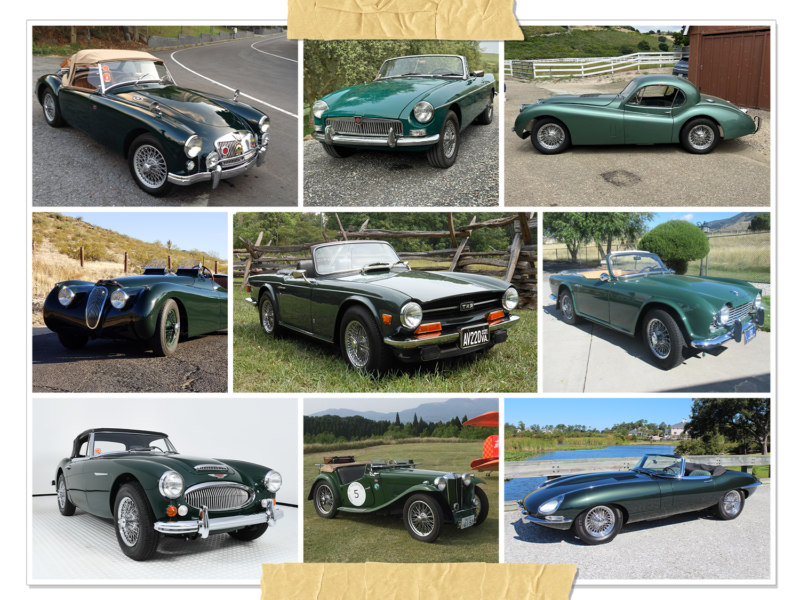By the mid-1950s, the MG and Jaguar nameplates already were well established in the United States market… synonymous with the term, sports car. But, you knew that already. Two additional nameplates appeared toward the middle of that decade in a quest for sales in a market just above the entry level MG and below the lofty Jaguar. Austin-Healey and Triumph were the new contenders for a slice of American pie.
There were both similarities and significant differences in the ways these marques approached the same objective. Neither Austin nor Triumph (Standard Triumph) previously had been perceived on these shores as a maker of sporty vehicles. Both were better known for their basic and mid range family saloons. Triumph had produced an unusual, bustle back, rumble seat roadster after WW II, the 1800/2000, one of which played a major role in one of my youthful adventures- But, that most definitely is another story.
For these new entries, styling honors had to go to the Austin Healey 100/4, which today is considered a milestone design some tony years after its debut as a 1954 model. The Healey featured an innovative fold-down windshield, appreciated less than it perhaps should have been because this was one of the last cars from anywhere to have side curtains. The Triumph TR2 was stubbier, boxier, something less than a styling tour de force. But, it was a tough competitor on the race track and in the showroom. Both were four bangers that laid claim to three figure top speeds, something that MG owners could not equal. The step up premium was about 25%.
Harry Blanchard, who operated Morlee Motors in Greenwich, CT, occasionally loaned us used sports cars from his lot to drive in rallies. And, in at least one instance we set off for the weekend in a black TR2. I recall two features, one favorable and the other was a true pain in the a—! First the bad news…unless one entered the Triumph very carefully, the sharp angle of the bodywork just aft of the door hit one’s tailbone, causing instant pain, followed by tenderness that lasted for days. The proper entry procedure was, needless to say, quickly learned. The other immediate attention getter was the size and number of gauges… they conveyed an impression of technical competence.
Other impressions recalled from the distant past include the well contoured, individually adjustable, leather covered seats with their tasteful pleating, gobs of low speed torque delivered by the two liter engine, from which emanated a pleasantly throaty, bordering on authoritative, exhaust note, compared to the MG TD and TF that previously had been my primary sports car experiences, the locking luggage compartment was spacious, though it actually was neat useless. Axle hop was noted under hard acceleration, but accepted as the price one paid for the sort of take off that led those aforementioned MGs a diminishing image in the convex rear view mirror.
Earlier, during the Korean war, I met one of my father’s friends in Tokyo. Recalled to the Air Force as a Major, Lee Chadwich eschewed the Gl staff car in favor of a squarish English sedan that looked for all the world like a miniature razor-edge-bodied Rolls Royce. Of course, this was a Triumph Mayflower, and it was meant to look like a miniature Rolls Royce.
Shortly after I joined the Morlee Motors sales department in 1958, another Triumph vignette occurred. I am reminded often of an easy sale to a young man, who announced that he was leaving with his new TR-3 for Hollywood, where he intended to become a movie producer. Martin Bregman kept his vow and made quite a name for himself. Does he still own the car… or even remember it… or the salesman from whom he purchased it?
One of my most pleasant Triumph memories is that the company had a truly first rate public relations man in the United States. Chris Andrews was an affable yer proper, very proper, Englishman who easily could have portrayed an umbrella-carrying Prime Minister.
Triumph was the basis for several smaller production marques, including Turner, an almost crude sports car that achieved superior performance through ruthless elimination of excess weight. This and the Peerless GT were products of England’s then prolific cottage indus
try that also produced nameplates like Allard, Kieft, ELVA and TVR. For that matter. TVR also opted for Triumph power before Jack Griffith suggested that a small block Ford V8 might make things more exciting.
No recollection of Triumph cars would be complete without Wall and Pat Stehman. Co-workers at American Cyanamid in Stamford, the couple maintained a TR3A, in top condition always, and were mainstays of the Westchester Sports Car Club’s seat-of-the- pants rallying program. Walt was the perfect exemplar of a 1950s sports car buff; sporting a pipe, cane, tweed hacking jacket as accessories for that red Triumph. On Wednesday evenings and Saturdays, Walt doubled for many years as a part-time salesman at Morlee Motors.
No Triumph remembrance can be complete without a few words about Bob Tullius. Others before Bob had raced Triumphs, even won with them. But, Tullius and his factory supported Group 44 generated a lot more ink in the sports car press. The timing may have had something to do with it, as SCCA’s C Production class, in the early 1970s became a face off between the traditional British sports car and the upstart Japanese, in the form of Datsun’s 240Z. If the eventual outcome was inevitable, Bob Tullius fought a valiant and colorful last ditch battle lasting several seasons. It provided American racing spectators with some of the most exiting, wheel to wheel competition ever.







'At Full Chat: Triumph Vignettes, Plus a Bit of History' has no comments
Be the first to comment this post!